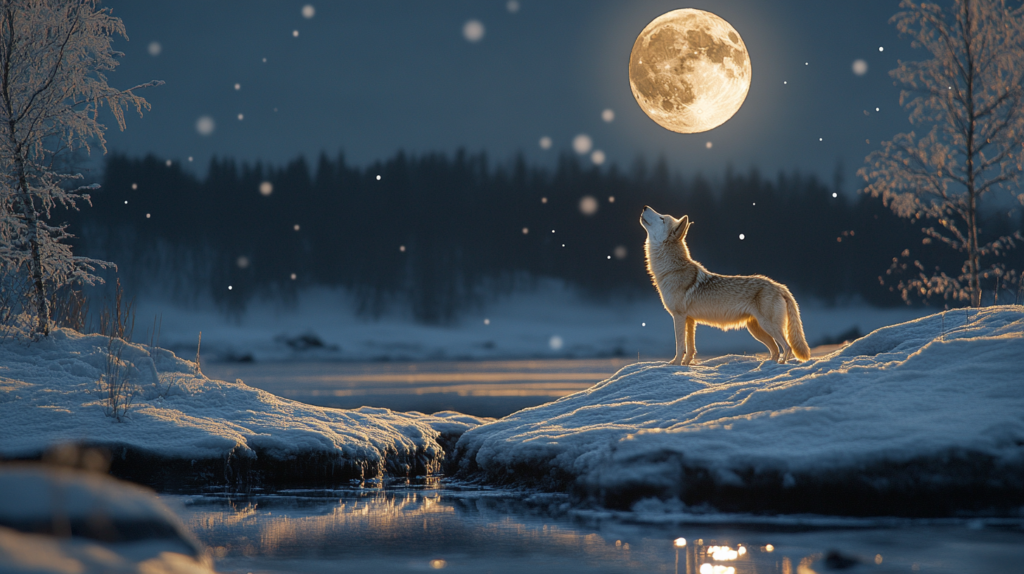It’s comforting knowing that we’re all living under the same sun, moon, and stars. No matter where you are in the world, we have that in common.
Every month, we look up at the night sky and see the bright, glowing disk of the moon at its fullest. Interestingly, each full moon of the year has a name, steeped in traditions from Native American, European, and other ancient cultures. These names often reflected the natural world or seasonal changes. Let’s take a journey through the year, one full moon at a time, and learn a bit about the history and meanings behind each.
January: Wolf Moon

The Wolf Moon takes its name from the howling of wolves during the cold winter months. In January, food was often scarce, and wolves could be heard in the distance, calling to each other. This moon symbolizes survival and strength during the bleakest part of winter. It’s a time when the land is usually frozen, and people historically had to rely on their community for warmth and sustenance.
February: Snow Moon

February’s full moon is called the Snow Moon, and it’s easy to see why. February tends to bring some of the heaviest snowfall in the Northern Hemisphere. In many cultures, this moon symbolized hardship and endurance, as food stores began to dwindle and survival became even more challenging. However, it also marked the growing anticipation of spring’s arrival.
March: Worm Moon

The Worm Moon in March signals the beginning of the thaw. As the snow melts and the ground warms, earthworms start to appear, bringing life back to the soil. This moon is often linked with renewal and transformation, as it aligns with the first signs of spring. It’s a reminder that the cycle of life is beginning again after the long winter.
April: Pink Moon

The Pink Moon is named after the early blooming pink wildflowers, known as creeping phlox, that appear in April. Though the moon itself isn’t pink, its name brings to mind the blossoming of spring and the return of color to the world. This moon represents rebirth, growth, and new beginnings as nature starts to wake up from its winter slumber.
May: Flower Moon

As the name suggests, May’s Flower Moon coincides with the peak of spring, when flowers are in full bloom. This moon is a celebration of life, fertility, and the abundance of the season. Many cultures saw this as a time of planting and preparation for the coming summer months, full of hope and the promise of growth.
June: Strawberry Moon

The Strawberry Moon gets its name from the ripening of wild strawberries, which are ready for harvest in June. This moon represents abundance, the sweetness of summer, and a connection to the earth’s bounty. For many Native American tribes, this was a time to gather food in preparation for the coming warmer months.
July: Buck Moon

The Buck Moon is named after the time of year when male deer, or bucks, begin to grow new antlers. July is a period of rapid growth for many animals, including these majestic creatures. This moon symbolizes strength, renewal, and the vitality of the animal kingdom, as summer takes hold and the days are long.
August: Sturgeon Moon

August’s full moon is called the Sturgeon Moon, named after the large freshwater fish found in the Great Lakes and other major bodies of water. For many Native American tribes, this was the best time to catch sturgeon. The moon represents the wealth of nature, the importance of water in sustaining life, and the interconnectedness of all living things.
September: Harvest Moon

The Harvest Moon is perhaps one of the most well-known, as it is the full moon closest to the autumn equinox. Farmers relied on its bright light to extend their harvest time into the night, gathering crops that were essential for survival through winter. This moon represents abundance, hard work, and the rewards of labor as the growing season comes to a close.
October: Hunter’s Moon

Following the Harvest Moon, the Hunter’s Moon in October signaled a time for hunting to stock up on meat for the winter months. Its bright light helped hunters track game late into the evening. This moon symbolizes preparation, survival, and the primal connection between humans and the natural world, as communities readied themselves for the harsh months ahead.
November: Beaver Moon

The Beaver Moon is named for the time of year when beavers are busy building their lodges and preparing for the winter. Trappers also set their beaver traps before the swamps froze over. This moon is a symbol of industriousness, planning, and the importance of preparing for the future before winter fully takes hold.
December: Cold Moon

As the name suggests, December’s Cold Moon reflects the chilly temperatures and long nights of winter. This moon represents endurance and reflection, as the year comes to an end and nature enters its quiet, resting phase. It’s a time to hunker down, take stock of the year, and prepare for the promise of a new beginning as the cycle starts again.

